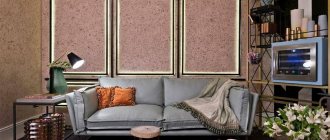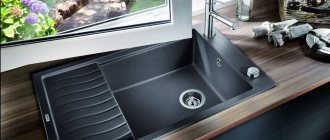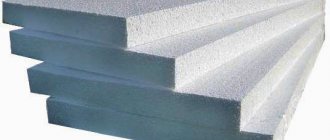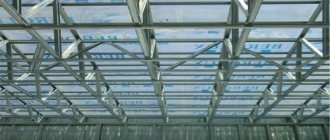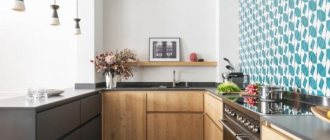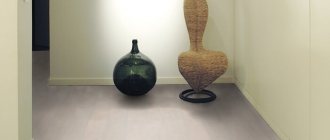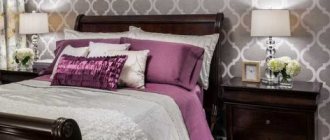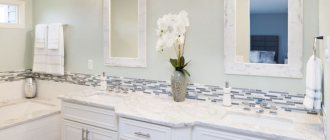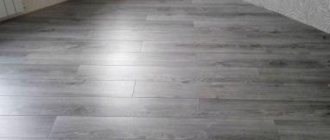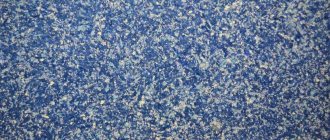Design and color
Modern linoleums have a variety of designs. You can choose a beautiful option for any interior. It can imitate parquet and tiles. There are options with drawings and oriental motifs.
Linoleum for the kitchen is presented on the modern market in a huge assortment.
A dark floor is not the best solution for a kitchen, provided it is small. This range visually compresses the room. Therefore, the kitchen may become even smaller
And if you want to use dark linoleum, it is important to think through everything carefully. For a spacious room, a shade of dark chocolate and dark gray is suitable
By adding light colors, you will get a contrast that will look stylish and noble.
For a small kitchen it is better to choose a light-colored coating. It visually expands the space and fills it with light. It is recommended to choose light linoleum with various patterns and designs. This way the interior will not look boring.
The surface of the canvas should not have deep ribbing or a relief pattern.
The coating can imitate various materials such as wood. There is also a “tiled” option. Ceramics are quite cold, so they are successfully replaced by linoleum, which imitates tiles. In addition to the traditional option, you can choose a product with some offset tiles, mosaics, or in the form of diagonal laying.
The chosen color must be combined with the rest of the color scheme in the kitchen.
It is better to choose linoleum with an anti-slip coating.
Types of PVC linoleum
The most beautiful linoleum is made from PVC, since this material allows you to create any color, pattern, texture. Based on the number of layers, PVC coating is divided into two types:
- Homogeneous;
- Heterogeneous.
Homogeneous linoleum is a single-layer coating consisting of talc, limestone and kaolin, which are coated with a protective composition of polyvinyl chloride. The disadvantage of this coating is regular maintenance, which requires cleaning off the outdated protective coating and applying a new one.
Heterogeneous linoleum consists of several separate layers, where strong fiberglass is used as a base, which is additionally impregnated with a polyvinyl chloride compound. The decorative layer of this coating is also made of PVC, which can have different colors and textures, applied by embossing. To protect the decorative surface, a thin layer of the same PVC is used.
Types of linoleum according to production technology:
According to production technology, homogeneous and heterogeneous linoleums are distinguished.
2.1 Homogeneous linoleum
Homogeneous is a sheet of material that is uniform throughout its entire volume, 1.5–3 mm thick, with a fairly simple pattern and texture, often “marbled,” intended for rooms with increased abrasion load: in shops, offices, corridors, gyms, airports. To reduce the cost of this type of coating, various fillers are used, such as limestone, talc or kaolin.
2.2 Heterogeneous linoleum
Multilayer material with a thickness of 2–6 mm, sometimes more, has a rather complex structure, the basis or skeleton of which is, as a rule, a reinforced fiberglass canvas 1.5–4.0 m wide. a layer of polyvinyl chloride, and on top of it a pattern that determines the design of the coating. The design is complemented by a high-strength protective film made of polyurethane or pure PVC. The protective layer may include plastic granules of various compositions, stone chips of various fractions or even metal dust, which creates a wealth of patterns, shades and textures, providing wide scope for the designer’s imagination. The thickness of the protective coating determines the wear resistance class of a particular brand of coating.
Heterogeneous varieties are distinguished by a richer design, a huge collection of patterns and a wide range of colors. However, the cost of this material is much higher, because all this is reflected in the cost of production. The standard structure of this material from bottom to top is approximately as follows:
- substrate;
- fiberglass;
- impregnation of fiberglass and a layer of PVC foam;
- layer that determines the design of the coating - pattern and texture;
- protective layer.
Substrate:
Its main function is protection from moisture, sound and heat insulation. Based on these considerations, the components of the substrate are selected. Basically it is PVC foamed mechanically or chemically. More expensive brands have insulated substrates.
1. Foamed PVC base.
The service life of such linoleum is up to 10 years. Its thickness reaches 3.5–4 mm, it is used in rooms with a slight excess of moisture - in bathrooms, kitchens, toilets, installation is very simple - with glue diagonally and along the edges of the sheet. To reduce the penetration of moisture, if necessary, the joints can be hot welded or sealed using special compounds called cold welding.
2. Insulated base.
The backing used here is felt, jute, artificial non-woven materials, synthetic and natural fabrics, and sometimes even pressed chips of cork tree bark. The thickness of such material can reach 5 or more millimeters. It is quite soft and elastic, retains heat well, is excellent for residential premises, but does not tolerate high humidity and is completely incompatible with the “warm floor” system. Among the disadvantages, one can also note its ability to expand slightly during operation. This must be taken into account during installation and a gap of approximately 5 mm should be left between the linoleum and the wall. It is better to mount it as a single sheet or carefully weld the joints to avoid moisture getting into the thickness of the substrate.
Linoleum - what is it?
Linoleum (Latin linum - flax, linen + oleum - oil) is a type of floor covering made of polymer materials. Available in roll form.History of the invention of linoleum
It is known that by oiling the fabric the Vikings gave the sails of their longships additional strength and protection from water and salt. The year 1627 marked the advent of the production of “oiled linen,” which can be considered a distant ancestor of linoleum. About a hundred years later, its use as a floor covering was recorded. Nathan Smith patented this material in 1763 with the following description: “... on the fabric there is a covering mass of a mixture of resin, oleoresin, Spanish brown dye, beeswax and linseed oil, which is applied while hot.”
In 1843, the use of natural rubber and the addition of ground cork in the production of canvas were first mentioned. This is how camptulikon appeared (Greek campto - to bend, bend). Kamptulikon was already a direct predecessor of linoleum. The material quickly gained popularity, but on June 10, 1846, R. W. Thomson patented the world's first automobile tire, which soon caused a jump in prices for the rubber used to produce camptulicon. Manufacturers began to look for replacements for raw materials that had become more expensive; linseed oil and linseed drying oil (later replaced by linoxin) became rubber substitutes.
On December 19, 1863, Englishman Frederick Walton received patent No. 209/1860 for the production of linoleum. It was the same camptulicone, but its ingredients did not contain rubber. Later, Scotsman Michael Nairn significantly improved the production technology of this floor covering.
Industrial production of linoleum first began in 1864 in the town of Staines, near London. Initially, linoleum was produced on a fabric (jute) basis from vegetable oils (linseed, sunflower, tung), cork flour, etc.) - the so-called glyphthalic linoleum.
At the beginning of the 20th century, the Russian Empire was one of the main producers of linoleum. The largest factories in Europe were located in Odessa and Riga. After the October Revolution of 1917, Russia fell behind and lost its position as a world leader in the production of floor coverings.
Due to the scarcity of raw materials (vegetable oil), glyphthalic linoleum has given way to polyvinyl chloride linoleum since the 1950s. In the USSR and other countries during this period, almost all production of linoleum from natural raw materials was closed. Polyvinyl chloride flooring is no longer linoleum, since its ingredients have nothing in common with those that Walton patented, but the new material retains the old name.
The oil crisis of 1973, which raised the price of oil (and, as a result, polyvinyl chloride), forced manufacturers to once again turn their attention to natural raw materials. This was also facilitated by the environmental movement around the world and the growing environmental literacy of the population. At the beginning of the 2000s, the global production volume of natural linoleum amounted to more than 40 million m²/year.
Modern technology for the production of linoleum is as follows: linseed oil is oxidized, and a special mixture is formed, called linoleum cement. The mixture is cooled and mixed with pine resin and wood chips to form linoleum sheets.
The world's largest producers of natural linoleum are Forbo (60% of production), DLW and Tarkett.
Application of linoleum
Linoleum is produced in the form of rolls from 6 to 45 m long, from 0.5 to 5 m wide with a thickness of 1.5 to 5 mm (special linoleums for installation in industrial, warehouse, public or sports facilities have a thickness of up to 8-9 mm ). Linoleum is laid or glued onto a flat, dry base using polymer mastics or special adhesives. In prefabricated housing construction, linoleum is used on a heat- and sound-insulating basis, so it can be laid directly on a concrete base.
Types of linoleum
By binding material
- Natural.
- Polyvinyl chloride.
- Rubber (relin).
- Nitrocellulose.
- Alkyd.
Natural and polyvinyl chloride are the most widely used in construction.
Natural linoleum is the oldest and most environmentally friendly finishing material of all linoleums; has high wear resistance, low flammability, strength, abrasion resistance, antistatic, good resistance to alkalis and acids and a relatively long service life. In dry and warm rooms it does not fade, does not wear off, does not crumble, does not emit strong odors, does not lose its original color, maintaining brightness for up to 20 years. It has the highest cost among all linoleums, it is very hard and fragile in the cold, and is susceptible to microorganisms and mold (rotting). Natural linoleum can be baseless or made from natural woven or non-woven materials (for example, jute, hemp or flax fiber). The composition of natural linoleum includes such natural ingredients as: linseed oil, pine resin, wood flour, lime powder and natural dyes.
By area of application
Household ones are made on a foam base and a polyester base. Thickness - 1-4 mm. Despite its small thickness, household linoleum has a rather complex structure. Service life under intensive load is no more than 2 years. Advantages: variety of colors and designs, softness, ease of installation and operation, and low price.
Commercial is used in rooms with maximum traffic and load, they are distinguished by high wear resistance among PVC linoleums and a small selection of decor.
Semi-commercial is similar in structure to household (base, decorative layer, protective layer), but has an increased thickness of the protective layer (up to 0.7 mm). Used in office and public spaces, walk-through living rooms.
Special - designed for special tasks. Linoleum with a sports coating has a protective polyurethane layer, which gives the material wear resistance and protects it from dirt. Linoleum with a bactericidal coating has a sterilizing effect and is used in medical institutions. Linoleum with an anti-slip coating is produced with the addition of quartz or corundum chips, which form a relief surface of the material. Linoleum with soundproofing coating is designed for rooms with special acoustic requirements.
Types of PVC coating
By structure
- Homogeneous - a fabric that is uniform throughout its entire thickness, the production of which uses PVC granules and dyes. The pattern is not located on the surface of the material, but permeates its entire thickness, and this is what characterizes the low abrasion of a homogeneous PVC coating. This PVC coating is usually used in high traffic areas.
- The structure of the heterogeneous PVC coating includes from 2 to 6 layers, and the thickness reaches 6 mm. The basis of heterogeneous PVC coating is fiberglass. Depending on the complexity and quality of the PVC coating, its structure includes from 1 to 6 layers of PVC, a backing made of natural fabric, non-woven fiber or foamed PVC.
Based on availability
- Baseless.
- Polyester pile backing.
- On a foamed PVC base.
Characteristics of linoleum
- Roll width.
- Weight per square meter.
- The total thickness of the linoleum sheet[1].
- Thickness of the top protective layer.
- Application class. Indicated by a two-digit number, the first digit of which indicates the type of premises (2 - residential, 3 - office, public, 4 - industrial), and the second - the degree of load intensity (1 - low, 2 - medium, 3 - high, 4 - very high) .
- Abrasion group:
F - the lowest degree of wear resistance (thickness change from 0.3-0.6 mm);
M - low degree of wear resistance (thickness change from 0.15-0.3 mm);
P - average degree of wear resistance (thickness changes from 0.08-0.15 mm);
T is the most wear-resistant layer (thickness change less than 0.08 mm).
- Abrasion.
- Resistant to furniture legs and shoe heels.
- The heat absorption coefficient is no more than 12 W/m²[2].
- Service life - 10-15 years.
Review of popular manufacturers
Well-known linoleum brands are a guarantee of quality and durability.
So, well-established linoleum manufacturers include:
- Forbo-Novilon. It produces high-quality products for both household and commercial purposes. A special feature of the coating is a fairly strong and hard protective layer, the thickness of which can reach 1 cm. In addition, many flooring models are made with a locking system, which improves the strength properties of linoleum;
- Domo floor. French manufacturer of PVC coatings with a beautiful decorative layer. The special manufacturing technology of Sensa System made it possible to produce a whole collection of various models that imitate the texture of solid wood and marble;
- Manufacturer of heterogeneous environmentally friendly coatings, which does not use heavy metals and caustic chemicals in the production of canvases.
In the process of choosing linoleum, you need to take into account several important criteria, namely: the number of layers and their thickness, the presence of a base, as well as the future operating conditions of the floor. In accordance with this, you can purchase linoleum of the required class with the necessary technical parameters, which will ensure a long period of its service.
We advise you to study - Which substrate to choose for laminate - manufacturers' recommendations
Classifications of linoleum
Homogeneous commercial linoleum covering
All types of PVC coatings can be classified according to three main criteria:
- structure;
- presence of a basis;
- scope of application.
As already noted, the structure of the flooring can be:
- Homogeneous. This is a single-layer, fairly thick material that is very abrasion resistant. It is not in danger of delamination, so even if its aesthetic appeal is lost, the floor surface can be polished by removing 15-20% of the layer. The high density of linoleum will ensure at least another 2-3 years of its operation even after restoration;
- Heterogeneous. May contain from 2 to 6 layers. Their number and composition are largely determined by future conditions of use. For rooms with high humidity, it is advisable to choose flooring with a rubber filler, for sports fields - with a thick foam layer, for enterprises with high traffic - with a reinforced protective and top layer.
In addition, linoleum and its technical parameters are determined by the presence of a base:
- Baseless. Wear-resistant material with a rough surface. Typically used in areas with very high traffic;
- Based. Produced on a woven or jute base. Thanks to their presence, the strength characteristics of the flooring, as well as its flexibility, are improved.
According to the scope of application, all types of PVC coatings can be divided into three categories:
- Domestic. Does not differ in high technical performance, which is due to low cross-country ability and load on the coating;
- Commercial. It has a very thick protective layer, thanks to which it can be used in commercial premises with a high degree of load: shopping centers, offices, exhibition halls, cafes, etc.;
- Specialized. During production, specific operating conditions are taken into account, and therefore floorings with bactericidal and anti-slip properties, increased sound insulation, etc. are produced.
Commercial linoleum
This is a coating characterized by increased wear resistance. This type of linoleum is painted over the entire thickness; it has a thicker protective layer. Mainly used in public buildings with a large flow of people, where a floor covering with the highest degree of wear resistance is required. Of course, it can also be used in residential buildings, but due to the high cost (10-40 euros per 1 m2), its use in residential premises is very limited, where you can be content with inexpensive and less wear-resistant linoleum.
Photo: linoleum-stroi.ru
Commercial linoleum has the following characteristics:
- Weight: 2.8 kg/m2
- Price: 10-40 euros
- Residual deformation: no more than 0.02-0.10 mm
- Protective layer: up to 0.8 mm
- Sound absorption: 6-10 dB
- Flexibility: when circling a rod with a diameter of 10-40 mm, there should be no cracks
Service life of this coating: 10-25 years. Depending on the manufacturing technology and composition of the PVC sheet, commercial linoleum can be heterogeneous or homogeneous. The following companies are engaged in the production of commercial linoleum: “LG Hausys floors” (South Korea), “Juteks” (Slovenia-Russia), “IVC” (Belgium), “Armstrong” (England), “Forbo”, “Tarkett”, etc.
Using commercial linoleum
Used in public places with high traffic (business and shopping centers, shops, educational institutions, offices, cinemas, etc.). This coating has increased wear resistance, fire safety in accordance with international standards ISO 9001 and ISO 14001, and resistance to detergents and other aggressive agents.
Properties and characteristics of linoleum flooring
Read the description and characteristics of linoleum as a floor covering for residential and public premises.
The description of linoleum fully corresponds to its name, which comes from two Latin words: “linum” - canvas and “oleum” - oil. Linoleum can be natural or artificial. Natural linoleum is a canvas coated with a mixture of oils, resins and mineral dyes. The backing of artificial linoleum is made of a material reminiscent of fiberglass in structure. This material bears the main strength load to which the coating is exposed during operation. The base of this flooring is impregnated with a special synthetic compound and the front side is covered with polyvinyl chloride (PVC). A pattern is rolled onto it, and then a protective layer of transparent polyvinyl chloride is applied. After this, the linoleum is subjected to heat treatment. In terms of strength, linoleum can be divided into commercial (the most durable) and household, designed for use in residential premises. Speaking about the properties and characteristics of linoleum, it is worth noting that commercial linoleum is more wear-resistant, since it is painted over the entire thickness. Due to this, the design is well preserved, even though the top layer wears off over time.
Currently, there are a lot of collections and many colors of artificial linoleum, and you can easily choose a floor covering for any room based on the overall interior design of the house. In addition, you can combine colors, create applications and create an exclusive floor.
For rooms where people stay for a short time, baseless linoleum is suitable, which is laid directly on the concrete screed. Another property of linoleum is its high thermal conductivity. Warm linoleum floors with a heat- and sound-insulating base are laid in living rooms. This coating consists of two layers, the top one is a polyvinyl chloride film, and the bottom one is an antiseptic felt lining.
The material should be kept in a horizontal position for several days. Thanks to this, the waviness disappears from its surface, and the lower side fits tightly to the surface of the base. When cutting linoleum, be sure to leave a reserve for shrinkage, which should be for sheet lengths up to 6 m - 2 cm, up to 10 m - 3-4 cm, more than 10 m - 5-6 cm.
Types of linoleum by properties
Linoleum can be divided into classes depending on what technical properties it has. The most important among them are the indicators of abrasion and wear resistance.
Abrasion refers to how rapidly the coating thickness decreases under load. There is a European classification EN660-1, on the basis of which linoleum is divided into four groups and has the following markings (the change in thickness after rolling in with a special roller is indicated in brackets):
- F – the cheapest and fastest abrasive class (0.6 mm);
- M – linoleum, which wears moderately (0.3 mm);
- P – low abrasion (0.15 mm);
- T – the most durable class (0.08 mm).
The wear resistance classification is based on the ability of the coating to withstand mechanical stress. The characteristics of linoleum are affected by its thickness if it is single-layer (homogeneous). If the material is heterogeneous, then the level of wear resistance depends on the thickness of the top layer.
To determine the wear resistance class, the marking of the European system EN 685 is used. The index consists of two digits. The first defines the scope:
- 2 – residential premises (houses, apartments, etc.);
- 3 – public places (kindergartens, schools, hospitals, offices, etc.);
- 4 – production premises (workshops, train stations, airports, etc.).
The second digit in the index indicates the intensity of the load:
- 1 – low;
- 2 – average;
- 3 – quite high;
- 4 – very high.
When choosing linoleum for your home, the following varieties are most optimal:
- 21 – for bedrooms, storage rooms and other rooms where the load on the coating is minimal;
- 22 – for children's rooms and living rooms;
- 23 – for vestibules, hallways with high intensity of use.
You can use other types of linoleum of a higher wear resistance class. However, the higher the class of floor covering, the more expensive it is.
Today, such types of linoleum are used as household, semi-commercial, commercial and special. They have different densities and areas of application. If you already know what type you will use, all that remains is to measure the room and decide on the standard size of the material.
The width of the purchased canvas must be at least 100 mm greater than the length of the wall against which measurements are taken.
How wide is linoleum? Manufacturers produce a wide range of linoleum coverings. Its width can be from 1.5 to 5 m in increments of 0.5 m. Thus, for any room you can easily select a roll of the appropriate size.
Negative points
Despite a number of advantages, ceramics also have disadvantages, which may have moved this material to 3rd place in the ranking:
- First of all, they note the very low temperature of the coating, which is very difficult to correct without a good heating system. It is advisable to install a “warm floor” under the tiles.
- The cost of tiles is much higher. An owner who finds ceramics at a low price should be wary of a fake, which such tiles will most likely turn out to be. Naturally, there can be no talk of any strength characteristics of such products.
- Laying ceramic tiles takes a lot of time, effort and money. It is best to entrust this procedure to a specialist, since a person who does not have certain skills is unlikely to be able to do the job efficiently.
- The coating created when laying tiles creates a risk of injury to residents. Poorly chosen tiles can slip, and a blow to a hard surface can cause injuries of varying severity.
Bottom line
Based on all of the above, we can conclude that linoleum is a coating whose installation in the kitchen is not only undesirable, but even contraindicated. It will be more practical and efficient to use tiles. The owner can only be advised that the choice is based on the criteria of convenience, and not the best design.
The tile must be of high quality, rough or coated with an anti-slip compound, meet the declared characteristics, etc. Installation should be entrusted to a specialist and then you can be sure that the coating will last a very long time without losing its positive qualities over time.
Types of linoleum by chemical composition:
1.1 Polyvinyl chloride (PVC):
The most common type of linoleum is polyvinyl chloride (PVC) homogeneous (without base) and heterogeneous (multilayer). The cheapest. The service life of PVC homogeneous linoleum reaches 5–7 years, on a foam basis - up to 10 years. It is dielectric, environmentally friendly, resistant to fungus and putrefactive bacteria, and has low thermal conductivity. For homogeneous varieties, the disadvantage may be an excessive amount of lime in its composition, which leads to the appearance of abrasions on the surface, and subsequently it begins to absorb dirt, which is almost not removed by detergents. In this case, an additional polyurethane protective layer or special mastic is required, which will have to be updated periodically. Excess lime can be determined by the fold of the strip of material. If the fold turns white, there is too much lime. If the bend breaks, there is much more lime than necessary.
In addition, homogeneous types have a fairly high shrinkage coefficient at high temperatures - up to 2%, and are unstable to reagents such as solvents and alkalis. The disadvantage is that PVC materials lose their elasticity when the temperature drops, and at sub-zero temperatures they can even burst. However, practicality, ease of installation and variety of design more than compensate for these minor shortcomings, which manifest themselves mainly in extreme conditions.
1.2 Nitrocellulose or colloxylin:
The least common type. More often it is produced in a cheap single-layer version without a base. Its advantages include low cost, high moisture resistance and elasticity over a wide temperature range. In addition, it has very low thermal conductivity, which is why it is in demand. Disadvantages - low fire resistance and low service life - only 3-6 years.
We advise you to study - Leveling the floor under the laminate depending on the base and the nature of the irregularities
1.3 Glypthal linoleum:
It is made by applying alkyd resins, a pigment pattern and filler to a woven substrate. In terms of heat and sound insulating properties, it significantly exceeds PVC materials and dampens vibrations quite well. Disadvantages include high fragility that appears over time, possible cracking during installation, as well as nonlinear changes in geometric dimensions along the transverse and longitudinal warp threads. Service life up to 7 years.
1.4 Relin or rubber linoleum:
It is mainly used for non-residential premises with high humidity. It has high elasticity and excellent water resistance. It is a two-layer sheet material in which the top layer is a mixture of synthetic rubber with filler and a decorative pigment pattern, and the bottom layer is crushed rubber with a bitumen binder.
1.5 Marmoleum:
Marmoleum has been known since the 17th century. It is positioned as the natural and most environmentally friendly of all linoleums, and accordingly its price is the highest. This is a multi-layer material, which may include wood flour, linseed oil, natural resins of various coniferous trees, lime flour, crushed cork bark, as well as natural pigments. As a rule, jute fabric is used as a base. It is resistant to fire, does not electrify, has some bactericidal properties, is resistant to chemicals and solvents, and is durable - the service life for some brands can reach 30 years or more.
Composition and structure of linoleum
Any type of linoleum, according to its internal structure and composition, is divided into homogeneous and heterogeneous.
Homogeneous linoleum is linoleum, the internal structure of which is made of one solid and single layer of material. This floor covering is highly durable and wear-resistant, is not subject to delamination, and can be restored. The base raw material of such linoleum is polyvinyl chloride, to which admixtures of plasticizers and pigments are added, such as lime flour, talc, kaolin.
Heterogeneous linoleum is a multilayer material and can consist of 6 layers. This coating is more convenient to install, but is less resistant to abrasion and is inferior in strength characteristics to homogeneous linoleum.
homogeneous homogeneous linoleum
Composition of linoleum made from artificial materials
There is a wide variety of combinations of materials in the composition of linoleum, but all varieties are characterized by the use of the same basic raw materials, which is the basis of linoleum.
- PVC linoleum, the base raw material is polyvinyl chloride, a common abbreviation is PVC. It is produced without a base or on a fabric and foam base. The structure can be single-layer or multi-layer.
PVC based linoleum. 1. on a foam base 2. on a felt base
- Rubber linoleum. The basic raw material for such a coating is two-layer or single-layer rubber, crushed rubber with bitumen and with admixtures of dyes. It is rarely used in residential premises due to its environmental friendliness. The coating is highly elastic and durable, with increased water resistance. Not environmentally friendly and fire hazardous.
- Alkyd linoleum. It is made from modified resins, with admixtures of fillers and dyes. The composition includes jute fabric. Its advantages: high noise insulation, insulating effect, wear resistance, durability. The disadvantages include increased fragility at low temperatures, therefore it is recommended for flooring in regularly heated rooms.
- Colloxylin linoleum. The main raw material of the material is a mixture of colloxylin, gypsum and red lead. Contains dyes. The material is highly elastic, moisture-resistant, wear-resistant and durable. However, it is fire hazardous.
Composition of linoleum from natural materials
It is made in a higher percentage from natural materials, no more than 30%. This linoleum contains:
- Linseed oil or linseed cement is the basis of the material. It is a particularly viscous and dense mass.
- Resin from coniferous or deciduous trees. Used to give linoleum strength and flexibility.
- Limestone. Used as a filler. Gives the coating high strength and wear resistance.
- Wood flour. It is also a filler, used to make linoleum smooth and resistant to fading.
- Natural based dyes. Used to produce a varied color palette.
- Jute fiber. A substrate is made from it for moisture-resistant qualities and as an obstacle to the proliferation of harmful microorganisms.
composition of natural linoleum
Wear resistance and applications
In terms of wear resistance, depending on the scope of application, three types of linoleum can be distinguished:
- domestic;
- commercial;
- semi-commercial.
Household linoleum
Suitable for installation only in residential premises and in places where the load is quite low and there is no high traffic. Otherwise, due to poor wear resistance and low strength, it will quickly lose its attractiveness.
It is very important to take into account the size of the floor, because if you have to connect several covering sheets, then the weakness of the seam will be added to the low endurance, which will further reduce the service life of the linoleum. Household linoleum will decorate any interior
Household linoleum will decorate any interior
Typically its thickness does not exceed 4 mm, and it is made of polyester or has a foam base. If it is possible to navigate by class, then these are 21, 22, 23 strength classes. Despite his low endurance, he has many positive qualities:
- affordable price;
- very easy to care for;
- many colors and styles;
- moisture resistance and thermal insulation;
- elastic coating;
- easy to transport.
Semi-commercial linoleum
Combines the characteristics of both household and commercial linoleum. Many types of semi-commercial linoleum allow it to be used not only in an apartment, but also in those rooms where there is a high load on the floor and high humidity, but also in some public places with not very high traffic.
Commercial linoleum
Its characteristics allow it to be safely laid on the floor in establishments with very high traffic. An interesting characteristic of the coating is that the pattern is not applied to the surface, but passes through the entire thickness of the coating, therefore, when the top layer is erased, the pattern does not disappear. This allows the coating to be used for a long time; the stated service life reaches 25 years.
About the structure of the material
Based on the number of layers that form the floor covering, linoleum is divided into single-layer (homogeneous) and multi-layer (heterogeneous).
Homogeneous linoleum is uniform in structure. It is a coating made of synthetic mass, the thickness of which varies from one and a half to three millimeters. Depending on the composition of the mass and the amount of impurities in it, the material may have different electrostatic characteristics, resistance to fading under the influence of sunlight, strength and wear resistance. For the last parameter, the thickness of the coating is also important, since it refers to abrasion resistance. Homogeneous linoleum can only be commercial or semi-commercial.
The typical structure of heterogeneous linoleum is four layers:
- fiberglass as a reinforcing base;
- main layer (polymer mass);
- decorative layer with a pattern applied to it;
- protective layer (PVC film or polyurethane).
This layer-by-layer layout of the floor covering is typical for baseless (non-insulated) linoleum. For a warm-based material, the base can be made of felt or jute (natural or artificial). This floor covering is thicker than the non-insulated version (5 mm or more), it is noticeably softer, and has good heat and sound insulation properties. Its only drawback is that the base is afraid of water. Such a covering should be laid without seams, and it can be used in rooms with a normal level of humidity, that is, not in the kitchen or bathroom.
Another option for insulated linoleum is a material based on a foamed polymer base. It is not afraid of high humidity, although it is not welcome, it prevents heat loss, and partially blocks extraneous noise. This flooring is soft and pleasant, but, unfortunately, short-lived. If the base is prepared poorly, its defects will be felt within a year or two from the start of operation. To correct this drawback, manufacturers add an additional reinforcing layer, usually made of fiberglass. It stabilizes the structure of the coating and its geometry, preventing minor unevenness of the base from appearing.
What class of linoleum is the best?
Many people are interested in which class of linoleum is the best. This cannot be determined with certainty. It all depends on the specific operating conditions:
- For the bedroom, a household type with a marking of 23 and a thickness of 1.5 mm is suitable;
- In the nursery it is worth laying a thicker covering, at least 3 mm. Natural is better;
- For the living room, choose semi-commercial with a thickness of 2 mm;
- A product of class 33 or more is suitable for the kitchen and hallway. A commercial one is better for the hallway, but a household one is suitable for the kitchen.
When arranging the interior of your apartment, read the reviews, choose linoleum not only by its pleasant color and texture, but also by the characteristics of the inner and lower layers.
For rooms with high humidity, it is worth choosing products that are resistant to such an environment.
All information about linoleum must be indicated on the packaging and reflected in the certificate. Therefore, before purchasing, you should carefully study the coverage data in order to choose the most suitable option for specific conditions. Then it will last longer.
Classes of linoleum for premises
Experts have developed a scale of classes for using linoleum for indoor use.
The first domestic option includes various residential premises where different classes of coating are used.
The most budget-friendly is class 21 linoleum, which is recommended for use in bedrooms, living rooms and some office spaces.
Linoleum classes and scope
The 22nd is denser and more durable, so it is advisable to lay it in the kitchen or nursery.
The most durable material among household linoleum is class 23.
For offices, floor coverings of 31-34 classes are recommended. This type is different:
- increased wear resistance;
- variety of colors and variety of designs;
- multilayer structure.
Class 31 material is used in office premises:
- small conference rooms that are not used on a regular basis;
- hotels;
- offices without visitors.
The 32nd has higher wear resistance and is widely used in offices, small shops, etc.
Class 33 is used at social and cultural facilities and in office centers.
The most durable and reliable is class 34 flooring, which can be used in large supermarkets and other public facilities.
Industrial linoleum of classes 41-43 has a high level of strength and wear resistance, which is the determining argument when calculating its cost: it is the most expensive. Application by class directly depends on the profile of industrial production.
Industrial linoleum has a high level of strength and wear resistance
How to choose linoleum in a store?
In order to choose the right linoleum and not stand in the store looking confused, we will then describe point by point what you need to know and what parameters to pay attention to when purchasing. This will make choosing a coating much easier.
- Color and texture. You need to decide on this first before going to the store. Use your imagination and look at product catalogs, determine which coating will suit your interior, select several colors and textures suitable for the room. Write these characteristics down on a piece of paper.
- Coverage class. When you have found linoleum that is suitable in appearance in the store, ask about the class of coating and whether it suits your room.
- Coverage dimensions. Measure the area of the room in advance and select the width of the linoleum so that it completely covers the surface without seams. For example, for a standard room of 3x6 meters, choose the same piece of covering in one piece.
- Environmentally friendly. Be sure to ask the seller to present a hygiene certificate or other quality certificates confirming that the material is safe. Use your sense of smell and smell the linoleum. If you smell strong chemical odors, then refuse to purchase, especially if you are choosing the coating for an apartment or private house. Remember, truly high-quality linoleum does not smell at all.
- Protective layer. Many coatings have additional antibacterial and protective coatings. This must be taken into account if you plan to cover a bathroom or bathhouse.
Be sure to unwrap the purchased material directly in the store, make sure that there are no mechanical damage, waves or swollen areas. Consider in advance whether it is possible to transport such a roll and how to bring it into the room through the staircase or passage rooms.
Do not fold the roll in half, this will damage the coating layers and the crack cannot be repaired. When transporting, do not wrap the roll with tape, with the sticky side facing the front surface of the material. Use protective film or fabric cover to protect the roll during transport.
Purpose of liquid linoleum
Initially, this type of coating was used for finishing floors inside industrial workshops. His task was to create a durable coating resistant to chemical and mechanical influences. Floors in factories and inside warehouses had to be resistant to abrasion, and not be afraid of the ingress of oils, the movement of loaded carts on them, or the impact of water during frequent cleaning of the floors. These are the properties that self-leveling floors have.
We advise you to study - Do-it-yourself gazebo made of wood
Polyurethane floor for workshop
However, now these types of bases are increasingly being used in household repairs. Owners of apartments and houses quickly realized that kitchen and bathroom floors should be as reliable as possible and not afraid of moisture. It is advisable that they do not leak in case of problems with the water supply and drainage system. Thus, liquid linoleum, which also has waterproofing properties, has become one of the best coating options for these premises.
Prices for self-leveling floors
Self-leveling floor Weber
Self-leveling floor in the corridor
Also, self-leveling floors are often used in shopping centers, dance and even sports grounds. Wear resistance allows them to be successfully used in car repair shops and premises where various complex technical work is carried out.
Self-leveling floor for car service
In general, this type of coating is recommended for use where special requirements are placed on the floor. For example:
- high abrasion resistance;
- presence of antistatic properties;
- increased level of waterproofing;
- resistance to chemicals.
Self-leveling 3D floor in the toilet
Characteristics, features and properties of linoleum
When purchasing a new type of flooring, you need to pay attention to its characteristics and properties. It should be remembered that as the grade increases, the cost of the material also increases.
In addition to strength and wear resistance, roll products have other properties, for example, the level of fire safety. This category can be divided into several subspecies:
- Flammability is the ability of a material to spontaneously ignite and maintain a fire at certain temperatures. This parameter ranges from 1 to 4. Number 1 indicates materials with the best degree of fire safety. It is not recommended to place flammable rolled products in places with large crowds of people, for example, in sales areas, industrial premises and office buildings.
- The smoke generation coefficient indicates the density of the smoke screen, measured in the range from 1 to 4, where 1 is smoke with a minimum density. For laying flooring in public buildings, the use of products marked D or higher is allowed. In this case, the rate of fire spread for linoleum should be at the lowest level.
- Flammability indicates the ability of a material to ignite. According to this characteristic, products are divided into easily flammable, moderately flammable and low-flammable.
- Another property of the material is toxicity. Harmful fumes enter the premises not only after using second-rate, low-quality raw materials, but also as a result of combustion. Poisoning with toxins is fatal in 80% of cases.
Important! Some solutions and finishing materials can increase the fire safety level of rolled products. It is recommended to lay linoleum on a special two-component adhesive that does not contain solvents.
The level of fire safety must be taken into account when purchasing rolled material for kindergartens, schools, hospitals and other public institutions. Always request quality certificates from the seller for the supplied products. In the marking of floor coverings, the following minimum characteristics are allowed: RP-1, V-2, T-2. Fire-resistant linoleum would be a good choice, but its price is significantly higher than the cost of standard products.
The thickness of the coating also matters; the thinner it is, the less wear resistance the material has. The thickness of the layer for household linoleum ranges from 1 to 3 millimeters, for semi-commercial or office – about 5 millimeters, for industrial – from 6 millimeters. The last type has the maximum thickness of the protective layer. Some products have a foamed polyvinyl chloride backing. This material insulates the room from extraneous noise and helps keep the room warm.
Types of linoleum
Linoleums are also divided according to the materials used. In this case, we can distinguish natural linoleum, rubber, PVC, hyphthalic and nitrocellulose.
Linoleum made from natural materials has the best properties. Commonly used are tree resin, linseed oil and cork meal. This type of flooring will last for many years and will not fade or crack. The natural option is a great choice for the kitchen because it does not absorb grease and creates an environment where it is difficult for bacteria to grow. In addition, natural linoleum retains its size, color and structure for many years.
Rubber linoleum has a high level of plasticity. The top layer is made of a special filler and rubber. This material is also moisture resistant.
Common PVC linoleum can be recognized by its specific smell, which takes a very long time to dissipate. The coating is available on different bases (and without a base at all). Attractive appearance, flexibility and elasticity, as well as an affordable price - all these parameters have brought PVC linoleum to the top of sales. But it also has a significant drawback - at low temperatures the coating can crack and even burst.
Hyptal linoleum is inferior to its PVC counterpart in terms of strength and flexibility. Cracks often appear on it. At the same time, it has excellent sound and heat insulation properties and is suitable for apartments in buildings with good audibility. It is worth considering one of its features: over time, the width of the stripes increases, but decreases in length.
Nitrocellulose provides the floor covering with elasticity and moisture resistance. This linoleum has a specific shine. But there is also an obvious drawback - a high fire hazard.
View
The type of linoleum is an important criterion that is determined initially, since manufacturers produce several varieties. Each of them has its own disadvantages and advantages, as well as certain features of use. All this should be taken into account when deciding which type of material to choose.
Natural
The composition includes the following components:
- linseed oil;
- cork and wood flour;
- limestone powder;
- pine resin;
- natural dyes.
Manufacturers use jute fabric as a basis. The result is an absolutely environmentally friendly coating that can be used for any room in the apartment, including the children's room. Allergy sufferers and asthmatics will live calmly in a house with such flooring without feeling any discomfort.
Natural linoleum in the interior
Among the advantages also stand out:
- abrasion resistance;
- maintaining the original color for many years;
- bactericidal properties;
- non-flammability;
- ease of care.
It is not recommended to lay natural flooring in rooms with high humidity levels.
PVC
PVC linoleum
Polyvinyl chloride, which is widespread today, is also used in the production of linoleum. Thanks to the use of innovative European technologies, the coating differs:
- thermal insulation properties;
- the presence of dielectric properties;
- environmental friendliness;
- resistance to rotting;
- ease of installation and maintenance;
- large selection of shades and patterns.
It is worth considering that this type is very sensitive to elevated temperatures, alkaline and chemical solvents. If the temperature drops sharply, the elasticity will become minimal.
Subspecies by place of use
Commercial linoleum
Linoleum can be:
- Commercial . Used in office premises, its average service life is about 20 years. The positive aspects are strength and wear resistance.
- Semi-commercial . It spreads both in offices and apartments. If this type is chosen for an office space, then the room should have little traffic, since the service life can be reduced to 7 years.
- Household . A thin and cheap coating that has the shortest service life - 5 years. It can only be used in residential premises.
Other varieties
Relin
It is worth saying about the less popular varieties of linoleum:
- Glypthal . The production process is quite simple: alkyd resins are applied to the fabric base. This allows you to give the material increased heat and sound insulation properties. True, the process of laying such material is not simple.
- Colloxylin . The coating contains nitrocellulose, a component that gives the coating moisture resistance, inflammability and elasticity. However, there are also disadvantages: sensitivity to temperature changes and a tendency to shrink.
- Relin . The production process is complicated, since the material consists of 2 layers: crushed rubber with bitumen and a mixture of pigment, rubber and special filler. Advantages include elasticity and moisture resistance.
Due to the fact that relin contains a large amount of harmful volatile substances, it is not recommended for laying it in residential premises.

